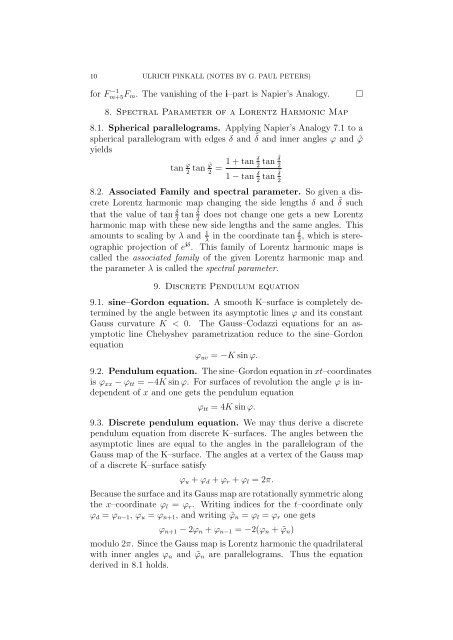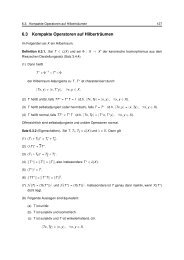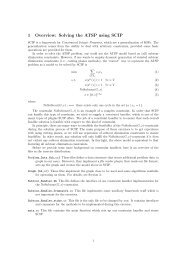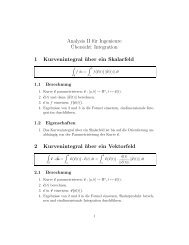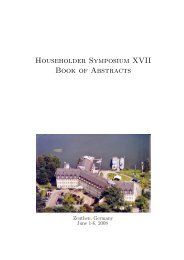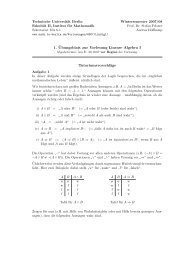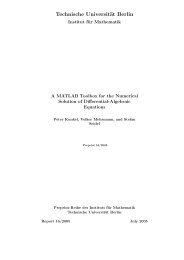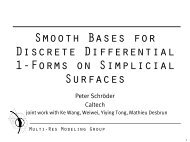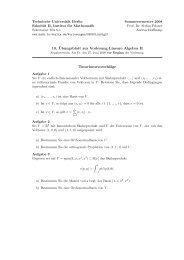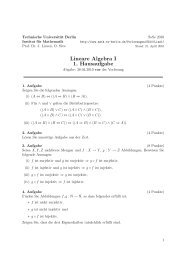Lecture notes - Institut für Mathematik - TU Berlin
Lecture notes - Institut für Mathematik - TU Berlin
Lecture notes - Institut für Mathematik - TU Berlin
Create successful ePaper yourself
Turn your PDF publications into a flip-book with our unique Google optimized e-Paper software.
10 ULRICH PINKALL (NOTES BY G. PAUL PETERS)for F −1m+5F m . The vanishing of the i–part is Napier’s Analogy.8. Spectral Parameter of a Lorentz Harmonic Map8.1. Spherical parallelograms. Applying Napier’s Analogy 7.1 to aspherical parallelogram with edges δ and ˜δ and inner angles ϕ and ˜ϕyieldstan˜δ2tan ϕ tan ˜ϕ = 1 + tan δ 22 21 − tan δ ˜δtan2 28.2. Associated Family and spectral parameter. So given a discreteLorentz harmonic map changing the side lengths δ and ˜δ suchthat the value of tan δ ˜δtan does not change one gets a new Lorentz2 2harmonic map with these new side lengths and the same angles. Thisamounts to scaling by λ and 1 in the coordinate tan δ , which is stereographicprojection of e iδ . This family of Lorentz harmonic maps isλ 2called the associated family of the given Lorentz harmonic map andthe parameter λ is called the spectral parameter.9. Discrete Pendulum equation9.1. sine–Gordon equation. A smooth K–surface is completely determinedby the angle between its asymptotic lines ϕ and its constantGauss curvature K < 0. The Gauss–Codazzi equations for an asymptoticline Chebyshev parametrization reduce to the sine–Gordonequationϕ uv = −K sin ϕ.9.2. Pendulum equation. The sine–Gordon equation in xt–coordinatesis ϕ xx − ϕ tt = −4K sin ϕ. For surfaces of revolution the angle ϕ is independentof x and one gets the pendulum equationϕ tt = 4K sin ϕ.9.3. Discrete pendulum equation. We may thus derive a discretependulum equation from discrete K–surfaces. The angles between theasymptotic lines are equal to the angles in the parallelogram of theGauss map of the K–surface. The angles at a vertex of the Gauss mapof a discrete K–surface satisfyϕ u + ϕ d + ϕ r + ϕ l = 2π.Because the surface and its Gauss map are rotationally symmetric alongthe x–coordinate ϕ l = ϕ r . Writing indices for the t–coordinate onlyϕ d = ϕ n−1 , ϕ u = ϕ n+1 , and writing ˜ϕ n = ϕ l = ϕ r one getsϕ n+1 − 2ϕ n + ϕ n−1 = −2(ϕ n + ˜ϕ n )modulo 2π. Since the Gauss map is Lorentz harmonic the quadrilateralwith inner angles ϕ n and ˜ϕ n are parallelograms. Thus the equationderived in 8.1 holds.□


